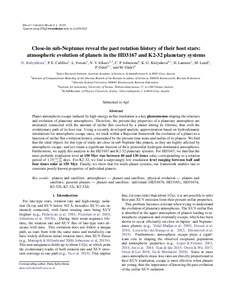Показать сокращенную информацию
Close-in sub-Neptunes reveal the past rotation history of their host stars: atmospheric evolution of planets in the HD3167 and K2-32 planetary systems
| Автор | Kubyshkina, D. | |
| Автор | Cubillos P. E | |
| Автор | Fossati, L. | |
| Автор | Erkaev, N. V. | |
| Автор | Johnstone C. P | |
| Автор | Kislyakova, K. G. | |
| Автор | Lammer, H. | |
| Автор | Lendl, M. | |
| Автор | Odert, P. | |
| Автор | Güdel, M. | |
| Дата внесения | 2020-01-20T08:04:33Z | |
| Дата, когда ресурс стал доступен | 2020-01-20T08:04:33Z | |
| Дата публикации | 2019-07 | |
| Библиографическое описание | Kubyshkina, D. Close-in sub-Neptunes reveal the past rotation history of their host stars: atmospheric evolution of planets in the HD3167 and K2-32 planetary systems [Текст] / D. Kubyshkina, Cubillos P. E, L. Fossati, N. V. Erkaev, Johnstone C. P, K. G. Kislyakova, H. Lammer, M. Lendl, P. Odert, M. Güdel // Astrophysical Journal. — 2019. — Т. 879 (№ 1). | |
| ISSN | 0004637X | |
| URI (для ссылок/цитирований) | https://iopscience.iop.org/article/10.3847/1538-4357/ab1e42/pdf | |
| URI (для ссылок/цитирований) | https://elib.sfu-kras.ru/handle/2311/129826 | |
| Аннотация | Planet atmospheric escape induced by high-energy stellar irradiation is a key phenomenon shaping the structure and evolution of planetary atmospheres. Therefore, the present-day properties of a planetary atmosphere are intimately connected with the amount of stellar flux received by a planet during its lifetime, thus with the evolutionary path of its host star. Using a recently developed analytic approximation based on hydrodynamic simulations for atmospheric escape rates, we track within a Bayesian framework the evolution of a planet as a function of stellar flux evolution history, constrained by the measured planetary radius. We find that the ideal objects for this type of study are close-in sub-Neptune-like planets, as they are highly affected by atmospheric escape, and yet retain a significant fraction of their primordial hydrogen-dominated atmospheres. Furthermore, we apply this analysis to the HD 3167 and K2-32 planetary systems. For HD 3167, we find that the most probable irradiation level at 150 Myr was between 40 and 130 times solar, corresponding to a rotation period of {1.78}-1.23+2.69 days. For K2-32, we find a surprisingly low irradiation level ranging between half and four times solar at 150 Myr. Finally, we show that for multi-planet systems, our framework enables one to constrain poorly known properties of individual planets. | |
| Тема | planets and satellites | |
| Тема | atmospheres | |
| Тема | gaseous planets | |
| Тема | HD 3167b | |
| Тема | HD 3167c | |
| Тема | HD 3167d | |
| Название | Close-in sub-Neptunes reveal the past rotation history of their host stars: atmospheric evolution of planets in the HD3167 and K2-32 planetary systems | |
| Тип | Journal Article | |
| Тип | Journal Article Preprint | |
| ГРНТИ | 41.23.17 | |
| Дата обновления | 2020-01-20T08:04:33Z | |
| DOI | 10.3847/1538-4357/ab1e42 | |
| Институт | Политехнический институт | |
| Подразделение | Кафедра прикладной механики | |
| Журнал | Astrophysical Journal | |
| Квартиль журнала в Scopus | Q1 | |
| Квартиль журнала в Web of Science | Q1 |

